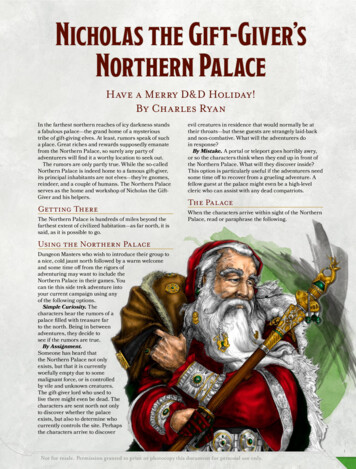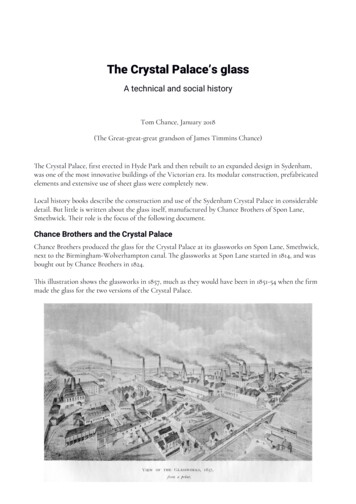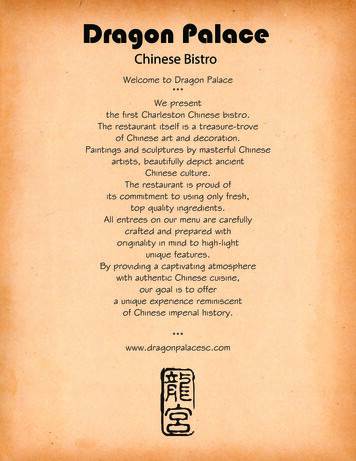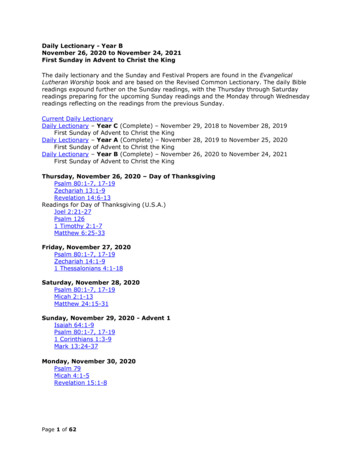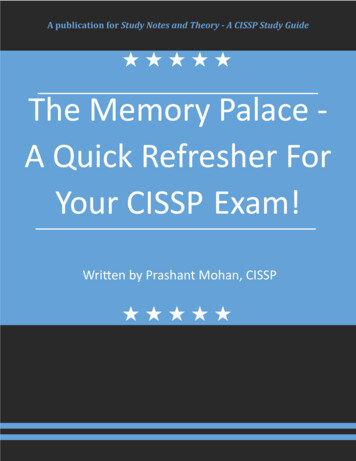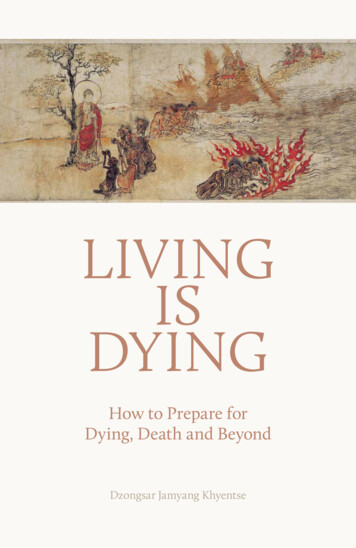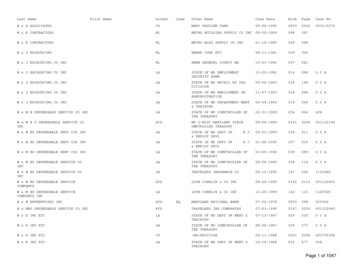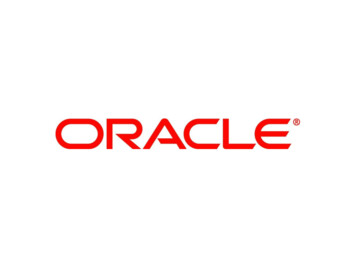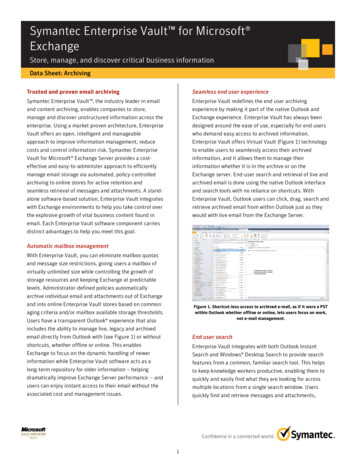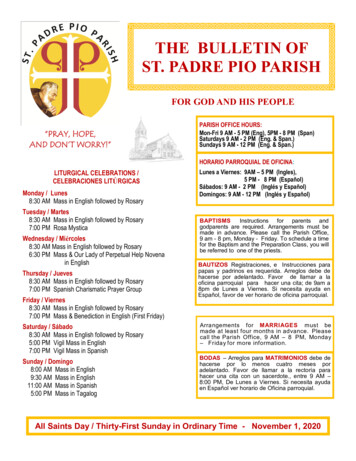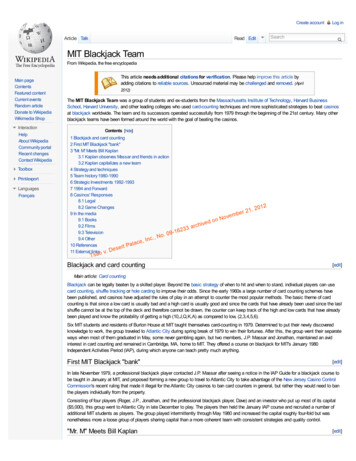
Transcription
Create accountArticle TalkRead EditLog inSearchMIT Blackjack TeamFrom Wikipedia, the free encyclopediaMain pageContentsFeatured contentCurrent eventsRandom articleDonate to WikipediaWikimedia ShopInteractionHelpAbout WikipediaCommunity portalRecent changesContact WikipediaToolboxPrint/exportLanguagesFrançaisThis article needs additional citations for verification. Please help improve this article byadding citations to reliable sources. Unsourced material may be challenged and removed. (April2012)The MIT Blackjack Team was a group of students and ex-students from the Massachusetts Institute of Technology, Harvard BusinessSchool, Harvard University, and other leading colleges who used card-counting techniques and more sophisticated strategies to beat casinosat blackjack worldwide. The team and its successors operated successfully from 1979 through the beginning of the 21st century. Many otherblackjack teams have been formed around the world with the goal of beating the casinos.Contents [hide]1 Blackjack and card counting2 First MIT Blackjack "bank"3 "Mr. M" Meets Bill Kaplan3.1 Kaplan observes Massar and friends in action3.2 Kaplan capitalizes a new team4 Strategy and techniques5 Team history 1980-19906 Strategic Investments 1992-19937 1994 and Forward8 Casinos' Responses8.1 Legal8.2 Game Changes2012r 21,e9 In the mediabmNove9.1 Booksd onevi9.2 Filmsarch623319.3 Television90No.9.4 OtherInc.,,ec10 ReferencesPalasert11 External linkso v. DeTsaBlackjack and card counting[edit]Main article: Card countingBlackjack can be legally beaten by a skilled player. Beyond the basic strategy of when to hit and when to stand, individual players can usecard counting, shuffle tracking or hole carding to improve their odds. Since the early 1960s a large number of card counting schemes havebeen published, and casinos have adjusted the rules of play in an attempt to counter the most popular methods. The basic theme of cardcounting is that since a low card is usually bad and a high card is usually good and since the cards that have already been used since the lastshuffle cannot be at the top of the deck and therefore cannot be drawn, the counter can keep track of the high and low cards that have alreadybeen played and know the probability of getting a high (10,J,Q,K,A) as compared to low, (2,3,4,5,6).Six MIT students and residents of Burton House at MIT taught themselves card-counting in 1979. Determined to put their newly discoveredknowledge to work, the group traveled to Atlantic City during spring break of 1979 to win their fortunes. After this, the group went their separateways when most of them graduated in May, some never gambling again, but two members, J.P. Massar and Jonathan, maintained an avidinterest in card counting and remained in Cambridge, MA, home to MIT. They offered a course on blackjack for MIT's January 1980Independent Activities Period (IAP), during which anyone can teach pretty much anything.First MIT Blackjack "bank"[edit]In late November 1979, a professional blackjack player contacted J.P. Massar after seeing a notice in the IAP Guide for a blackjack course tobe taught in January at MIT, and proposed forming a new group to travel to Atlantic City to take advantage of the New Jersey Casino ControlCommission's recent ruling that made it illegal for the Atlantic City casinos to ban card counters in general, but rather they would need to banthe players individually from the property.Consisting of four players (Roger, J.P., Jonathan, and the professional blackjack player, Dave) and an investor who put up most of its capital( 5,000), this group went to Atlantic City in late December to play. The players then held the January IAP course and recruited a number ofadditional MIT students as players. The group played intermittently through May 1980 and increased the capital roughly four-fold but wasnonetheless more a loose group of players sharing capital than a more coherent team with consistent strategies and quality control."Mr. M" Meets Bill Kaplan[edit]
In May 1980 JP Massar, known as "Mr. M" in the History Channel documentary, overheard a conversation about professional blackjack at aCambridge Chinese restaurant. J.P. introduced himself to the speaker, Bill Kaplan, a 1980 Harvard MBA graduate who had run a successfulblackjack team based in Las Vegas three years earlier. Kaplan earned his BA at Harvard in 1977 and deferred his admission to HarvardBusiness School for a year, during which time he moved to Las Vegas and formed a team of blackjack players based on his research and ownstatistical analysis of the game. Staked by funds he received upon graduation as Harvard's outstanding scholar-athlete, Kaplan generated a35 fold rate of return in less than nine months of play during this "year off."[citation needed]Kaplan continued to run his Las Vegas blackjack team as a sideline while attending Harvard Business School but, by the time of hisgraduation in May 1980, the players were so "burnt out" in Nevada they were forced to hit the international circuit. Not feeling he couldcontinue to manage the team successfully while they traveled throughout Europe and elsewhere, encountering different rules, playingconditions, and casino practices, Kaplan parted ways with his teammates, who then splintered into multiple small playing teams in pursuit ofmore favorable conditions throughout the world.Kaplan observes Massar and friends in action[edit]After meeting Kaplan and hearing about his blackjack successes, Massar asked Kaplan if he was interested in going with a few of Massar'sblackjack-playing friends to Atlantic City to observe their play. Given the fortuitous timing (Kaplan's parting with his Las Vegas team), heagreed to go in the hopes of putting together a new local team that he could train and manage.Kaplan observed Massar and his teammates playing for a weekend in Atlantic City. He noted that each of the players used a different cardcounting strategy which were overly complicated. This resulted in error rates that undermined the benefits of the more complicated strategies.Upon returning to Cambridge, Kaplan detailed the problems he observed to Massar.Kaplan capitalizes a new team[edit]Kaplan said he would back a team but it had to be run as a business with formal management procedures, a required counting and bettingsystem, strict training and player approval processes, and careful tracking of all casino play. A couple of the players were initially averse to theidea. They had no interest in having to learn a new playing system, being put through "trial by fire" checkout procedures before being approvedto play, being supervised in the casinos, or having to fill out detailed player sheets (such as casino, cash in and cash out totals, time period,betting strategy and limits, and the rest) for every playing session. However, their keen interest in the game coupled with Kaplan's successfultrack record won out.The newly capitalised "bank" of the MIT Blackjack Team started on 1 August 1980. The investment stake was 89,000, with both outsideinvestors and players putting up the capital. Ten players, including Kaplan, Massar, Jonathan, Goose,12and 'Big Dave' (aka 'coach', to20,doubled1distinguish from the Dave in the first round) played on this bank. Ten weeks later they morethanthe original stake. Profits per hour2rbeplayed at the tables were 162.50, statistically equivalent to the projected raten of 170/hourovem detailed in the investor offering prospectus. Per theNovedplayers paid in proportion to their playing hours and computerterms of the investment offering, players and investors split the profitsrchiwitha323 players, mostly undergraduates, earned an average of over 80/hour whilesimulated win rates. Over the ten week period of this firstbank,9-16o.of0250%.investors achieved an annualized return in excessN,.ce, InalacPtr[edit]seStrategy and vtechniques. DeTsaoThe team often recruited students through flyers and across the players' friends throughout college campuses across the country. The teamtested potential members to find out if they were suitable candidates and, if they were, the team thoroughly trained the new members free.Fully trained players had to pass an intense "trial by fire," consisting of playing through 8 six-deck shoes with almost perfect play, and thenundergo further training, supervision, and similar check-outs in actual casino play until they could become full stakes players.The group combined individual play with a team approach of counters and big players to maximize opportunities and disguise the bettingpatterns that card counting produces. In a 2002 interview in Blackjack Forum magazine,[1] John Chang, an MIT undergrad who joined theteam in late 1980 (and became MIT team co-manager in the mid 1980s and 1990s), reported that, in addition to classic card counting andblackjack team techniques, at various times the group used advanced shuffle and ace tracking techniques. While the MIT team's cardcounting techniques can give players an overall edge of about 2 percent, some of the MIT team's methods have been established as gainingplayers an overall edge of about 4 percent.[citation needed] In his interview, Chang reported that the MIT team had difficulty attaining such edgesin actual play, and their overall results had been best with straight card counting.The MIT Team's approach was originally developed by Al Francesco, elected by professional gamblers as one of the original seven inducteesinto the Blackjack Hall of Fame. Blackjack team play was first written about by Ken Uston, an early member of Al Francesco's teams. Uston'sbook on blackjack team play, Million Dollar Blackjack, was published shortly before the founding of the first MIT team. Kaplan enhancedFrancesco's team methods and used them for the MIT team. The team concept enabled players and investors to leverage both their time andmoney, reducing their "risk of ruin" while also making it more difficult for casinos to detect card counting at their tables.Team history 1980-1990[edit]The MIT Blackjack Team continued to play throughout the 1980s, growing to as many as 35 players in 1984 with a capitalization of as muchas 350,000. Having played and run successful teams since 1977, Kaplan reached a point in late 1984 where he could not show his face inany casino without being followed by the casino personnel in search of his team members. As a consequence he decided to fall back on hisgrowing real estate investment and development company, his "day job" since 1980, and stopped managing the team. He continued foranother year or so as an occasional player and investor in the team, now being run by Massar, Chang and Bill Rubin, a player who joined theteam in 1984.The team played on and off the next few years but interest waned as casino conditions, player exhaustion, and weakened management focuscaused the group to lose players and finally stop playing.[citation needed]The MIT Blackjack Team ran at least 22 partnerships in the time period from late 1979 through 1989. At least 70 people played on the team in
some capacity (either as counters, Big Players, or in various supporting roles) over that time span. Every partnership was profitable during thistime period, after paying all expenses as well as the players' and managers' share of the winnings, with returns to investors ranging from4%/year to over 300%/year.Strategic Investments 1992-1993[edit]In 1992, Bill Kaplan, J.P. Massar, and John Chang decided to capitalize on the opening of Foxwoods Casino in nearby Connecticut, wherethey planned to train new players. Acting as the General Partner, they formed a Massachusetts Limited Partnership in June 1992 calledStrategic Investments to bankroll the new team. Structured similar to the numerous real estate development limited partnerships that Kaplanhad formed, the limited partnership raised a million dollars, significantly more money than any of their previous teams. Coincident with this newfunding, the three general partners ramped up their recruitment and training efforts to capitalize on the opportunity.Over the next two years, the MIT Team grew to nearly 80 players, including groups and players located in Cambridge, New York, New Jersey,Pennsylvania, California, Illinois, and Washington. Sarah McCord, who joined the team in 1983 as an MIT student and later moved toCalifornia, was added as a partner soon after SI was formed and became responsible for training and recruitment of West Coast players.At various times, there were nearly 30 players playing simultaneously at different casinos around the world, including Native American casinosthroughout the country, Las Vegas, Atlantic City, Canada, and island locations. Never before had casinos throughout the world seen such anorganized and scientific onslaught directed at the game. While the profits rolled in, so did the "heat" from the casinos, and many MIT Teammembers were identified and barred. These members were replaced by fresh players from MIT, Harvard, and other colleges and companies,and play continued. Eventually, investigators hired by casinos realized that many of those they had banned had addresses in or nearCambridge, and the connection to MIT and a formalized team became clear. The detectives obtained copies of recent MIT yearbooks andadded photographs from it to their image database.With its leading players banned from most casinos and other more lucrative investment opportunities opening up at the end of the recession,Strategic Investments paid out its substantial earnings to players and investors and dissolved its partnership on December 31, 1993.1994 and Forward[edit]After the dissolution of Strategic Investments, a few of the players took their winnings and split off into two independent groups, theAmphibians who were primarily led by Semyon Dukach and the Reptiles who were led by Mike Aponte, Manlio Lopez and Wes Atamian.These teams had various legal structures, and at times million dollar banks and 50 players. By 2000, however, the 15 year reign of the MITBlackjack Teams came to an end as players drifted into other pursuits.2, 201In 1999, a member of the Amphibians won at Max Rubin's "3rd Annual Blackjack Ball"mcompetition.er 21 The event was featured in an October 1999bveunofficial title "Most Feared Man in the CasinoNothearticle of "Cigar Aficionado" magazine. According to the article, the winner earnedd onev[2]iBusiness".arch6233190No.[edit]Casinos' ResponsesInc.,,ecalaPsertLegal[edit]v. DeoaTsCasinos would often ban card counters from the blackjack table, the casino grounds, or all resort property if they were caught. Catching cardcounters however was hard for casinos because the best person for reporting card counting was often the dealer and the team is reported tohave tipped dealers very well to discourage dealers from notifying casino owners. Some casinos however, purchased lists of pictures of cardcounters from private companies to be used to identify and ban card counters before they could reach the blackjack tables. Breaking a banwould result in legal prosecution for trespassing. Cities with casinos often placed laws to combat card counting and other methods the MITblackjack team may have used by banning some methods. Card counting however was not made illegal anywhere.Game Changes[edit]While the rules to blackjack were not significantly changed, casinos began to encourage dealers to shuffle more often to make countingharder. Shuffling though, could not be used in excess because too much of it bored non-card-counting gamblers and kept the casino fromearning money because any time spent in which people were not betting was a waste for the casino. Switching between multiple decks toallow faster changing was an easy alternative to shuffling but was still not effective enough. Electronic blackjack is becoming increasinglycommon but is not seen by many to be a sufficient replacement for regular blackjack.In the media[edit]Books[edit]A variety of stories about a few of the players from the MIT Blackjack Team formed the basis of The New York Times Best Seller, BringingDown the House written by Ben Mezrich. While originally marketed as nonfiction, Mezrich later admitted that the characters and stories inthe book were mostly fiction and composites of players and stories he heard about third-hand. The private investigation firm referred to asPlymouth in Bringing Down the House was Griffin Investigations.[3]Mezrich wrote a follow-on book, Busting Vegas, that took even greater liberty with the actual happenings of the team.Jeffrey Ma wrote a book called "The House Advantage Playing the Odds to Win Big in Business" in it he discusses some of the time hespent on the 1994 MIT blackjack team.Films[edit]The 2004 film, The Last Casino, is loosely based on this premise and features three students and a professor counting cards in Ontarioand Quebec.[4]
The 2008 movie, 21, inspired by Bringing Down the House and produced by and starring Kevin Spacey and Jim Sturgess, was released onMarch 28, 2008 by Columbia Pictures. Jeff Ma and Henry Houh, former players on the Team, appear in the movie as casino dealers andBill Kaplan appears in a cameo in the background of the underground Chinese gambling parlor scene. The movie took significant artisticlicense with the history of the team with nearly every story being made up for the movie.Television[edit]The "Mysteries at the Museum" series on the Travel Channel featured the story of the MIT Blackjack Team in the episode titled "SiameseTwins, Assassin Umbrella, Capone's Cell"The story of the MIT Blackjack Team, in its incarnation as Strategic Investments, was told in The History Channel documentary, BreakingVegas, directed by Bruce David Klein.The Bringing Down The House period was featured on episodes of the Game Show Network documentary series, Anything to Win, andHBO's Real Sports with Bryant Gumbel (episode 116).The BBC documentary, Making Millions the Easy Way, addressed the Bringing Down the House period as part of the renowned "Horizon"strand (directed by Johanna Gibbon), told the story of a Strategic Investments breakaway group, and revealed the science behind thewinning formula.The TV series, Numb3rs had a storyline in which a High School teacher is leading a card counting group in Atlantic City which laundersmoney through casino winnings.Season 3 Episode 18, Like a Virgin, makes reference to a team of card counters that acts in a similar fashion to the MIT BlackJack TeamOther[edit]Several members of the two teams have used their expertise to start public speaking careers as well as businesses teaching others how tocount cards. For example:Mike Aponte of the Reptiles co-founded a company with former MIT Blackjack Team member David Irvine called the Blackjack Institute.Semyon Dukach of the Amphibians founded Blackjack Science.References1.2.3.4.[edit] Blackjack Forum interview with Johnny Chang The Twenty One Club: The annual blackjack ball hosts Gambling's Most Furtive (and Quirky) Fraternity cigaraficionado.com, Sept/Oct 1999 Ian Kaplan (March 2004). "review of Bringing Down the House" .012 The Last Casino at the Internet Movie Database.Retrieved on 2009-11-03.21, 2rmbeoveon NExternal linksdhive3 arc326"Inc. Magazine: Business Lessons from the Blackjack-1 King"o. 09"Newton Man, Bill Kaplan, Provides ,Inspirationc., N for Kevin Spacey's Character in 21"nIce and card countingalateamCitynet Magazine article ront Ptheese"Chet CurtisaReportv. Don NECN: Interview with Bill Kaplan" - videoTs oTalks 21" Raw Vegas - video"Mike Aponte"Math Whiz Breaks The Blackjack Bank" Fox News DC - video"Interview with MIT Mike" BlackjackInfo.com"The MIT Team's 500,000 Weekend" Midwest Gaming and TravelWired Magazine: Hacking Las VegasBBC documentary about card counting and the TeamUSA Today Q&A with Bill Kaplan (with photo)MIT Blackjack TeamMassachusetts Institute of Technologyv · t · ]Academics · School of Architecture and Planning · School of Engineering · School of Humanities, Arts, and Social Sciences · School of Science ·MIT Sloan School of Management · Division of Health Sciences and Technology · OpenCourseWare · Mathematics Department ·Broad Institute · Center for Theoretical Physics · Computer Science and Artificial Intelligence Laboratory · Koch Institute ·Laboratory for Electromagnetic and Electronic Systems · Laboratory for Information and Decision Systems · MIT Libraries · Lincoln Laboratory ·McGovern Institute · Media Laboratory · Picower Institute · Plasma Science and Fusion Center · Research Laboratory of Electronics ·MIT Senseable City Lab · MIT Nuclear Reactor Lab · Whitehead Institute · MIT Center for International Studies ·Alumni · Faculty · Presidents · Institute Professors · William Barton Rogers ·History · List Visual Arts Center · Traditions and activities · MIT in popular culture · Technology Review · Athena · Brass Rat · Hacks · The Tech ·TMRC · Tech Squares · MIT 100K · Mystery Hunt · Smoot · Lemelson–MIT Prize ·Campus · Chapel · Green Building · Infinite Corridor · Kresge Auditorium · MIT Museum · Stata Center · Wiesner building · Graduate Residences ·Undergraduate Residences · Fraternities and Sororities ·Rate this pageView page ratingsWhat's this?TrustworthyObjectiveCompleteI am highly knowledgeable about this topic (optional)Well-written
Categories: Massachusetts Institute of Technology student life American blackjack players Harvard UniversityThis page was last modified on 13 November 2012 at 19:47.Text is available under the Creative Commons Attribution-ShareAlike License; additional terms may apply. See Terms of Use for details.Wikipedia is a registered trademark of the Wikimedia Foundation, Inc., a non-profit organization.Contact usPrivacy policy About Wikipedia Disclaimers Mobile view1, 201623. 09-Tsaoserv. Deact Paloc., Ne, Ined ohiv3 arcnNber 2ovem12
In May 1980 JP Massar, known as "Mr. M" in the History Channel documentary, overheard a conversation about professional blackjack at a Cambridge Chinese restaurant. J.P. introduced himself to the speaker, Bill Kaplan, a 1980 Harvard MBA graduate who had run a successful blackjack team based in Las Vegas three years earlier.
